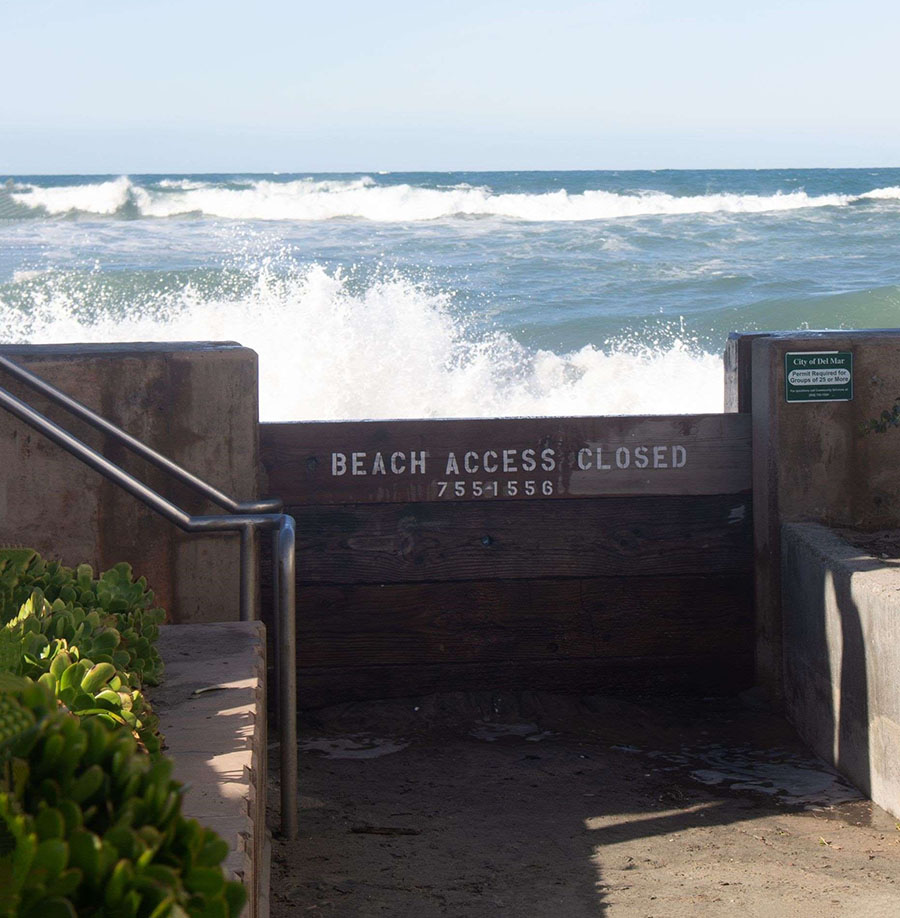 May 19, 2021 — The beach belongs to everyone. But sea level rise caused by climate change means certain populations may be less and less able to access this natural resource.
May 19, 2021 — The beach belongs to everyone. But sea level rise caused by climate change means certain populations may be less and less able to access this natural resource.
Two Environmental Science & Resource Management (ESRM) faculty members from CSU Channel Islands (CSUCI) will study the problem after receiving $396,060 for a project called “Sustaining Beaches and Social Equity under Higher Sea Levels: An interdisciplinary case study of the Santa Barbara Littoral Cell.”
Assistant Professors of ESRM Kiki Patsch, Ph.D. and Dan Reineman, Ph.D. are leading the research team, which is creating job opportunities for CSUCI students—13 of whom will be hired over the summer.
“Our previous work has found that, by virtue of living closer, whiter, wealthier people have more coastal access than non-white, less wealthy people,” Reineman said. “Sea level rise will definitely reduce the availability of coastal access opportunities. As for whether this will have inequitable impacts on underserved and underprivileged communities—answering that question is one of the goals for our research.”
The CSUCI funds are part of a larger $1.1 million grant for sea-level rise research from California State University Council on Ocean Affairs, Science and Technology (COAST) and California Sea Grant, which is a collaboration of the National Oceanic and Atmospheric Administration (NOAA), the State of California and universities across the state for research, products and services that benefit state of California.
The $1.1 million grant, which was administered through COAST’s State Science Information Needs Program (SSINP), will support 11 researchers and more than 20 students at six different CSU campuses.
Funding for the SSINP comes from a $3 million state appropriation to the CSU for research that addresses California’s ocean and coastal science needs.
“We are delighted to fund research that is directly applicable to state needs, while providing experiential learning and workforce training for our students,” said COAST Director Krista Kamer, Ph.D.
CSUCI’s coastal research project was born out of previous work done on California’s beaches by ESRM faculty members, who looked at a variety of coastal issues such as erosion, microplastics, sand dwellers, geography and the economic and recreational value to beachgoers.
Reineman has conducted research on community access to the beach and Patsch specializes in coastal geology and the changing shape of the shore, so the scientists combined their interests to develop the project. The team also includes San Francisco State University Associate Professor of Economics Phillip King, Ph.D. and Professor Nina Roberts, Ph.D., who serves as Director of the San Francisco State University, Department of Recreation, Parks, & Tourism, as well as Charles Lester, Ph.D., Director of the Ocean and Coastal Policy Center in the Marine Science Institute at UC Santa Barbara.
Student and faculty researchers will look at factors such as who has access to the beach, who is prevented from going to the beach and why, and what’s happening with rising sea level along what’s known as the Santa Barbara Littoral Cell, extending 144 miles from the mouth of the Santa Maria River to the Mugu Submarine Canyon. A littoral cell is a distinct area of the coastline where sand enters the ocean, flows down the coast, and then is removed from the system.
Patsch and Reineman will be paired with San Francisco State University Associate Professor of Economics Phillip King, Ph.D. and Nina Roberts, Ph.D., who serves as Director of the San Francisco State University, Department of Recreation, Parks, & Tourism.
The research team will also include Director of the Ocean and Coastal Policy Center in the Marine Science Institute at UC Santa Barbara (UCSB) Charles Lester, Ph.D.
“Sea level is rising at an unprecedented pace,” Patsch said. “Our models are underpredicting sea level rise and it’s going to be a problem sooner than we think, along with other coastal risks from increases in El Niños, fires, storm surges, and so forth. If sea level rises three feet by 2050, communities like the Oxnard Plain and Carpinteria will be facing extreme flooding events.” These events will have consequences for the beaches themselves and who can access them.
The $1.1 million of funding will also be used for sea level rise research at CSU Fullerton and CSU Long Beach.
All research teams will consult with state of California agencies as they begin their projects so that the results are as useful as possible to the state. Once CSUCI’s 30-month research project is complete, the findings will be integrated into an existing beach sustainability database that can be used by the California Coastal Commission and other state agencies to make management decisions.
“California’s coast is valuable, it is vulnerable, and it belongs to all of us,” Reineman said. “But if we don’t protect it, we could lose it forever. And if we do protect it, but not carefully, consciously and equitably, we might save our beaches, but only for a privileged few. This research will equip us with strategies not only for sustainably managing our beaches into the future, but for making them as equitably accessible to California’s large and diverse population.”
To learn more visit: https://www.bsa-camp.org/.
